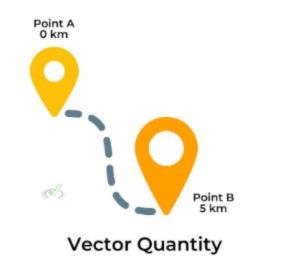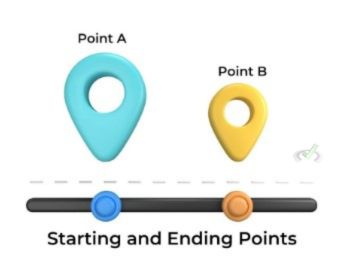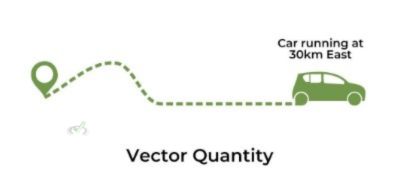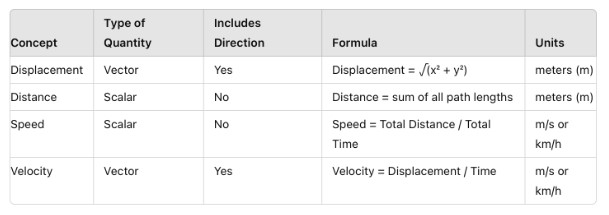Imagine you're on a road trip. The journey involves moving from one place to another. You might be interested in how far you travel, how fast you're going, and in what direction.
Similarly, we use displacement, velocity, and speed to describe motion in physics. These concepts are important for understanding how objects move and interact in our world.
I. Displacement
Displacement refers to the change in position of an object. It's a vector quantity, which means it has both magnitude (size) and direction.
- Vector Quantity: Displacement considers both how far you have moved and in what direction. This makes it different from distance, which only considers how far you have moved.

- Starting and Ending Points: It's the straight-line distance from your starting point to your ending point, regardless of the path taken.

- Units: Usually measured in meters (m) or kilometers (km).
Example: If you walk 3 meters north and then 4 meters east, your total displacement isn't 7 meters. Instead, you'd use the Pythagorean theorem (a2+b2=c2) to find the straight-line distance from start to finish. This distance is 5 meters northeast.
The formula for Displacement:

II. Speed
Speed is fast an object is moving. Unlike displacement, speed is a scalar quantity. This means it only has magnitude, not direction.
Key Points
- Scalar Quantity: Only considers how fast you're going, not where you're going. This means it doesn't account for direction.
- Average Speed: Total distance traveled divided by the total time taken.
- Instantaneous Speed: Speed at any given moment.
Formula for Speed
Example: If you travel 100 meters in 10 seconds, your speed is 100 meters10 seconds=10 m/s10 seconds100 meters=10 m/s.
III. Velocity
Velocity is the speed of an object in a particular direction. It's also a vector quantity. This means it considers both how fast the object is moving and in which direction.
Key Points
- Vector Quantity: Includes both speed and direction, making it different from speed.

- Average Velocity: Total displacement divided by the total time taken.
- Instantaneous Velocity: Velocity at any specific point in time.
The formula for Velocity:

Example: If you drive 60 kilometers north in 2 hours, your velocity is 60 kilometers/2 hours=30 km/h north.
IV. Differences and Relationships
Understanding how displacement, velocity, and speed are related helps solve physics problems.
Table: Comparison of Displacement, Distance, Speed, and Velocity

V. Example Problem
Let's solve a simple problem to see these concepts in action.
Problem: A car travels 40 kilometers west in 1 hour, then 30 kilometers east in 2 hours. What are the car's displacement, average speed, and average velocity?
Solution:
- Displacement: The car ends up 10 kilometers west of its starting point.
- Total Distance: 40 km + 30 km = 70 km.
- Total Time: 1 hour + 2 hours = 3 hours.

VI. Related Topics in Advanced Physics and MCAT Preparation
Understanding displacement, velocity, and speed lays the groundwork for more advanced topics. In higher-level physics, these concepts expand into other areas.
Acceleration
Acceleration is the rate at which velocity changes with time. It's a vector quantity, so it has both magnitude and direction.
Formula for Acceleration

Where Δv is the change in velocity, and Δt is the change in time.
Kinematic Equations
Used to calculate various aspects of motion when acceleration is constant. These equations include:

Newton's Laws of Motion
Newton's laws of motion are fundamental principles that explain the relationship between the motion of an object and the forces acting on it.
- First Law (Inertia): An object at rest stays at rest, and an object in motion stays in motion unless acted upon by a force.
- Second Law: The acceleration of an object is directly proportional to the net force acting on it and inversely proportional to its mass.
- Third Law: For every action, there is an equal and opposite reaction.
Force and Energy
In physics, force, and energy are related concepts that describe how objects move and interact.
Work
Work is done when a force is applied to an object, causing displacement.
Formula for Work

Where W is work, F is force, dd is displacement, and θ is the angle between the force and displacement.
Kinetic Energy
Kinetic energy is the energy of an object due to its motion.
The formula for Kinetic Energy

Where KE is kinetic energy, m is mass, and v is velocity.
Potential Energy
Potential energy is the energy stored in an object due to its position or state.
The Formula for Gravitational Potential Energy

Where PE is potential energy, m is mass, g is the acceleration due to gravity, and h is height.
Conservation of Energy
This states that energy cannot be created or destroyed; it can only be transferred or converted from one form to another. This means the total energy in a closed system remains constant.
VIII. Wrap-Up and Key Terms
Displacement, velocity, and speed are fundamental concepts in physics that describe how objects move. Grasping these ideas is crucial for solving physics problems and understanding more complex topics in future studies.
Key Terms:
- Displacement: Change in position of an object (vector).
- Speed: How fast an object is moving (scalar).
- Velocity: Speed in a specific direction (vector).
- Scalar Quantity: Has only magnitude.
- Vector Quantity: Has both magnitude and direction.
- Acceleration: The rate of change of velocity (vector).
- Force: An interaction that changes the motion of an object.
- Kinetic Energy: Energy of motion.
- Potential Energy: Stored energy due to position or state.
IX. Practical Test
Here are two multiple-choice questions to test your understanding of displacement, velocity, and speed.
Sample Practice Question 1
A cyclist travels 3 km north, then 4 km east. What is the cyclist's displacement?
A. 7 km
B. 5 km
C. 1 km
D. 12 km
Ans. B
The displacement is the straight-line distance from the starting point to the endpoint, which is calculated using the Pythagorean theorem:

Sample Practice Question 2
If a car travels at a steady speed of 60 km/h for 2 hours, what is the total distance traveled by the car?
A. 30 km
B. 120 km
C. 60 km
D. 100 km
Ans. B
The distance traveled is calculated by multiplying the speed by the time: 60 km/h×2 hours=120 km.








 To help you achieve your goal MCAT score, we take turns hosting these
To help you achieve your goal MCAT score, we take turns hosting these 





















 reviews on TrustPilot
reviews on TrustPilot